Manaslu Circuit Trek - 14 Days
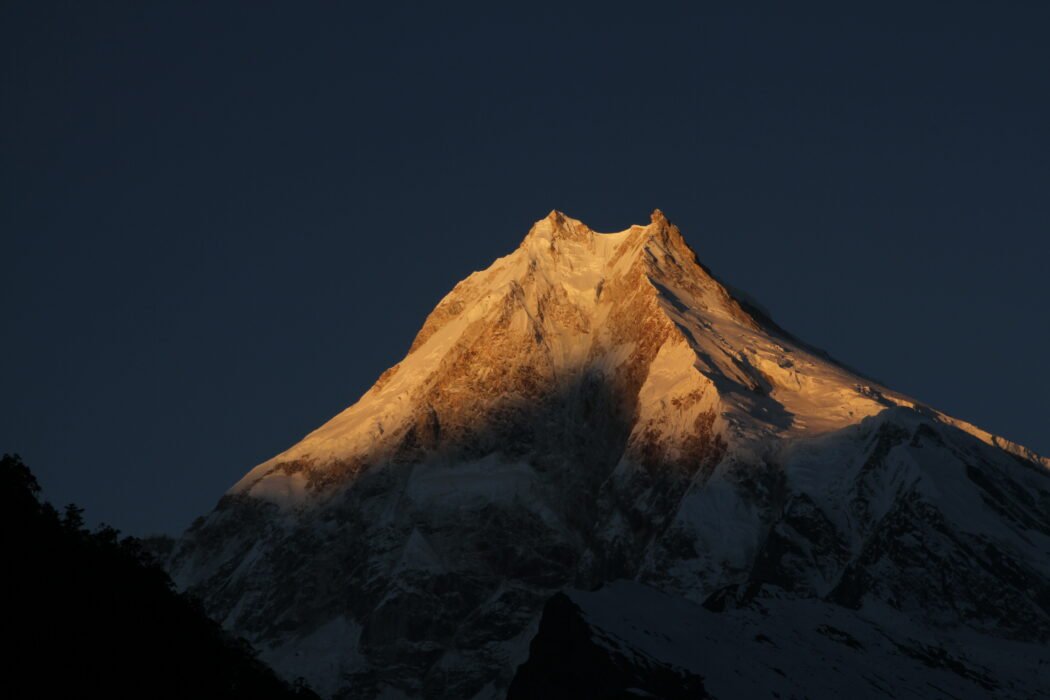
-
Duration:
14 days -
Max Altitude:
5106m -
Difficulty Level:
Strenuous -
Group Size:
1- 15 Person -
Destination:
Larkya – La pass 5160m. -
Accommodation:
Hotel/Lodges -
Transportation:
Bus, Car, Jeep or Van -
Trekking Season:
March to May and September to December
Trip Overview
The Manaslu Circuit Trek 14 Days is an incredible venture around Mount Manaslu, the eighth-highest peak in the world, having rugged trails and pristine beauty. Round Manaslu Trek features all remote trails with rich cultural immersion and breathtaking views of the Himalayas; it can fight with the best ones, such as that of the return trip to Annapurna.
The beginning of the 14 Days Mansalu Circuit Trek is from Kathmandu by way of rugged mountain tracks. Machha Khola to Jagat forms the start of this amazing trek. Trekkers will see diverse landscapes, from lush forests and terraced fields to high alpine areas. The highlight of Round Manaslu Trek is the crossing of Larkya La Pass (5,106m), which draws out breathtaking panoramic views.
The trail takes a cultural turn as trekkers will visit traditional Tibetan-influenced villages, such as Sama Gaun and Samdo. Monasteries that are centuries old, mani walls, and a deeply spiritual Buddhist culture provide depth to this nexus of nature.
The 14 Days Manaslu Circuit Trek is considered moderately strenuous and best undertaken in Spring or Autumn when skies are generally clear and weather stable. What Manaslu Circuit Trek insinuates is not pure isolation; rather, the trek will show you the incomparable combination of serenity, adventure, and richness in a culture that allows for professionals.
Preparation for Manaslu Circuit Trek 14 Days
Required Permits
If you are planning to go on a trek to the Manaslu Circuit, then permits are necessary, as this region is restricted. The following permits are very important:
- The Manaslu Special Restricted Area Permit (RAP)
- Manaslu Conservation Area Project (MCAP)
- Annapurna Conservation Area Project (ACAP)
The Manaslu Special Restricted Area Permit (RAP)’s cost generally varies with the seasons. For the fall season, that is, September to November, the cost of $100 per person is charged for the first week, and $15 is charged for each subsequent day. For the other months, that is, December to August, the price charged is $75 for the first week and $10 for each day afterward.
Another permit that would be required is the Manaslu Conservation Area Project (MCAP). This permit costs NPR 3000 ($25) per person, regardless of the number of days. Finally, if the trekking route includes Annapurna, a permit for the Annapurna Conservation Area Project (ACAP) is also required. This permit costs NPR 3000 ($25) for international trekkers, and this cost is lower for nationals of SAARC countries and Nepali citizens.
Guides & Porters
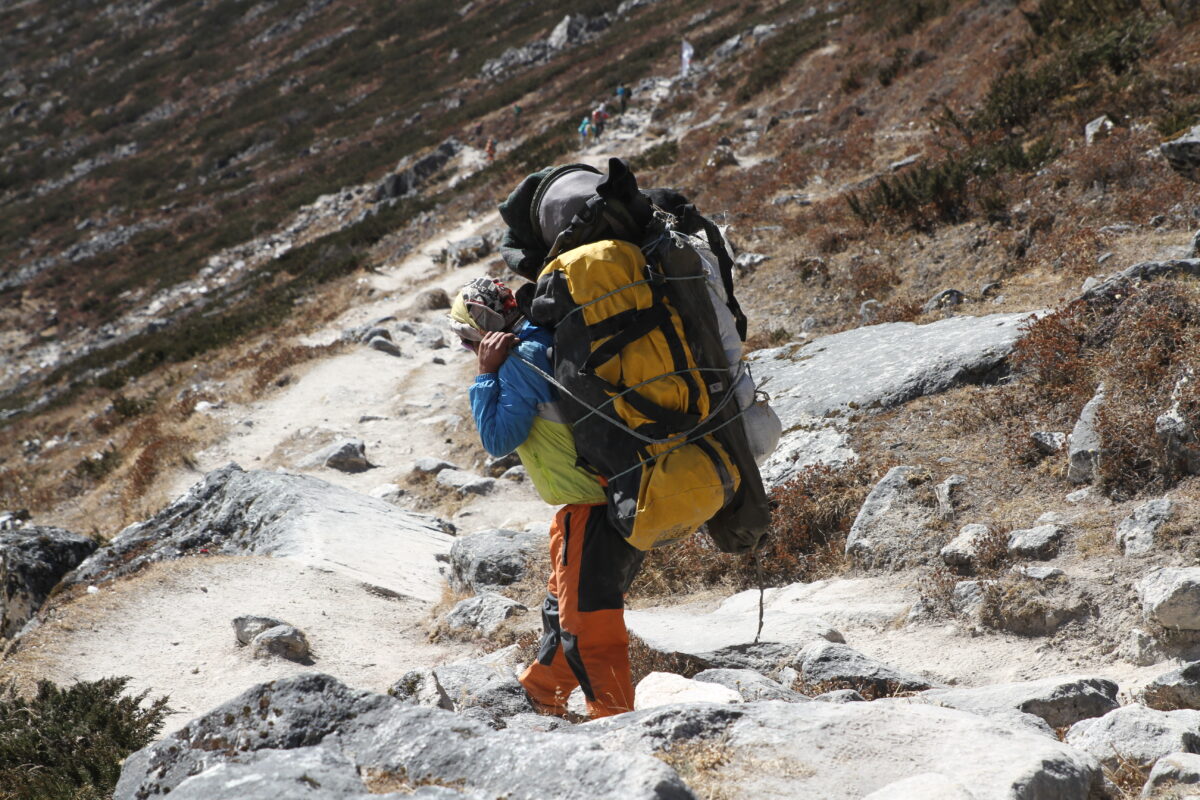
It is compulsory to hire a qualified guide for the Manaslu Circuit Trek. No independent trekking is allowed on this trail. Qualified guides are local specialists familiar with safety measures and enrich your experience with insights about culture, geography, and traditions. Their expertise can be the last resort in an emergency or while navigating remote trails.
In addition, porters are required to help you carry your backpacks and enjoy the trek. They are expert mountain trails and can help guide the trekking pace. Generally, the cost of hiring a guide is around $25 to $35 per person per day. Similarly, it costs around $20 to $30 per person to hire porters for the 14 Days Manaslu Circuit Trek.
Manaslu Circuit Trek Elevation and Altitude
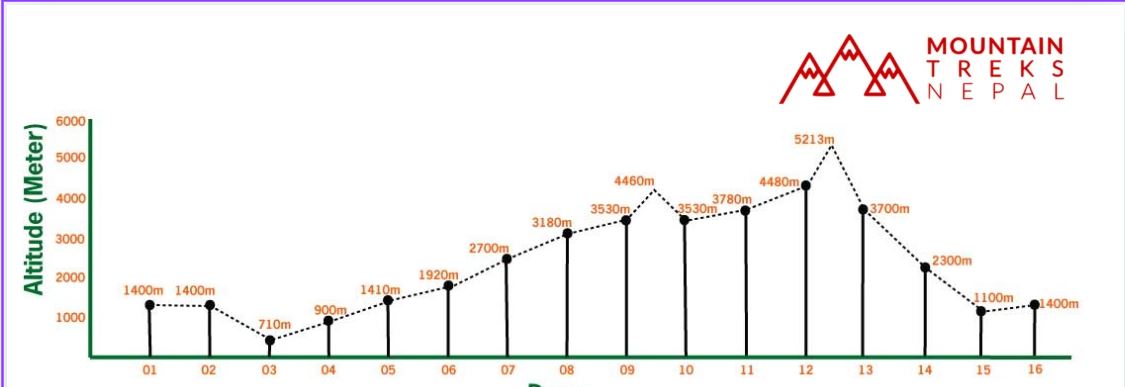
Altitude Sickness on the Manaslu Circuit Trek: What You Need to Know
The Manaslu Circuit Trek reaches a maximum elevation of 5,106 meters at Larkya La Pass, making it a high-altitude trek with a real risk of altitude sickness (AMS – Acute Mountain Sickness). Anyone ascending above 3,000 meters can be affected, regardless of fitness level or experience.
Symptoms of Altitude Sickness:
- Headache
- Nausea or vomiting
- Dizziness
- Loss of appetite
- Difficulty sleeping
- Fatigue or shortness of breath at rest
Prevention Tips:
- Hydrate aggressively – Drink at least 4–5 liters of water per day
- Ascend slowly and allow time to acclimatize, especially at Samagaon and Samdo
- Avoid alcohol and smoking
- Eat light but frequent meals
- Listen to your body – never push through symptoms
Medication & Remedies:
- Diamox (Acetazolamide) is commonly used to prevent or reduce symptoms. Take only with medical approval and drink plenty of water (minimum 4 liters/day) when using it.
- Hot garlic or ginger soup can provide natural relief and aid acclimatization.
If Symptoms Get Worse:
- Stop ascending immediately. Stay at your current altitude or descend.
- Inform your guide right away they are trained to handle altitude-related emergencies.
- If necessary, evacuate to the nearest health post or lower village for medical attention.
- Do not ignore symptoms. AMS can be fatal if untreated.
At Mountain Treks Nepal, your guide is equipped with a pulse oximeter, emergency oxygen, and is trained in high-altitude response. Your safety is our top priority.
Trip Grade: Fitness, Health, and Medical Requirements
The Manaslu Circuit Trek is a moderate to challenging trek that demands strong physical fitness and stamina. Covering approximately 180 kilometers over 13 days, you’ll be trekking 6–8 hours daily across steep ascents, rocky trails, and high-altitude terrain.
Fitness Requirements
To complete the trek comfortably, trekkers should:
- Be capable of long-duration hiking with a backpack
- Have good cardiovascular endurance
- Be prepared for high-altitude trekking
- Train ahead of time with cardio exercises, hiking, cycling, or stair climbing
Even if you’re not an athlete, regular physical preparation can make a big difference in your comfort and safety on the trail.
Medical Considerations
- This trek reaches altitudes above 5,000 meters, so it’s not recommended for individuals with severe heart conditions, chronic respiratory issues, or uncontrolled high blood pressure.
- If you have any pre-existing medical condition, consult your doctor before booking and inform your guide at the start of the trip.
- Trekkers must carry necessary medications and notify the team of allergies or medical needs.
- Travel insurance with emergency evacuation coverageis mandatory for this trek.
Your health is your greatest asset on the trail. At Mountain Treks Nepal, we prioritize your well-being with trained guides, emergency protocols, and altitude monitoring equipment.
Best Time To Go For Manaslu Circuit Trek 14 Days
Spring (March to May)
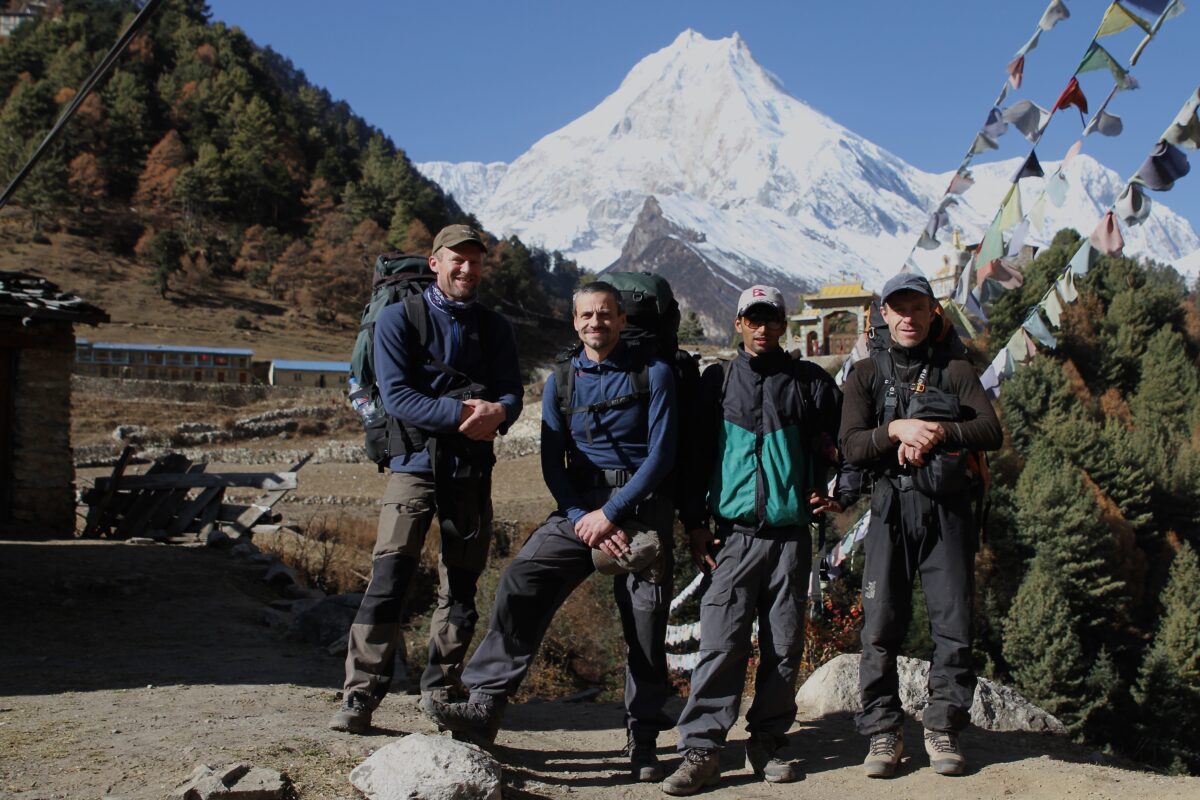
Manaslu Circuit Trek is best done during the Spring. Good weather envelopes the place with bright sunshine, and the average temperature during the day can range anywhere from 10 to 20 degrees centigrade in the lower areas. Still, the upper heights can drop below freezing. The trails are rich with the blooming of rhododendrons and lush green scenery all around.
The Spring season also gives wonderful sights of snow-peaked mountains like Manaslu and Shringi Himal. The weather is mild, and the trails are really very good for trekking. Some pre-monsoon downpours could take place at the end of May, but this does not often hinder the trip, so it is an unforgettable journey.
Autumn (September to November)
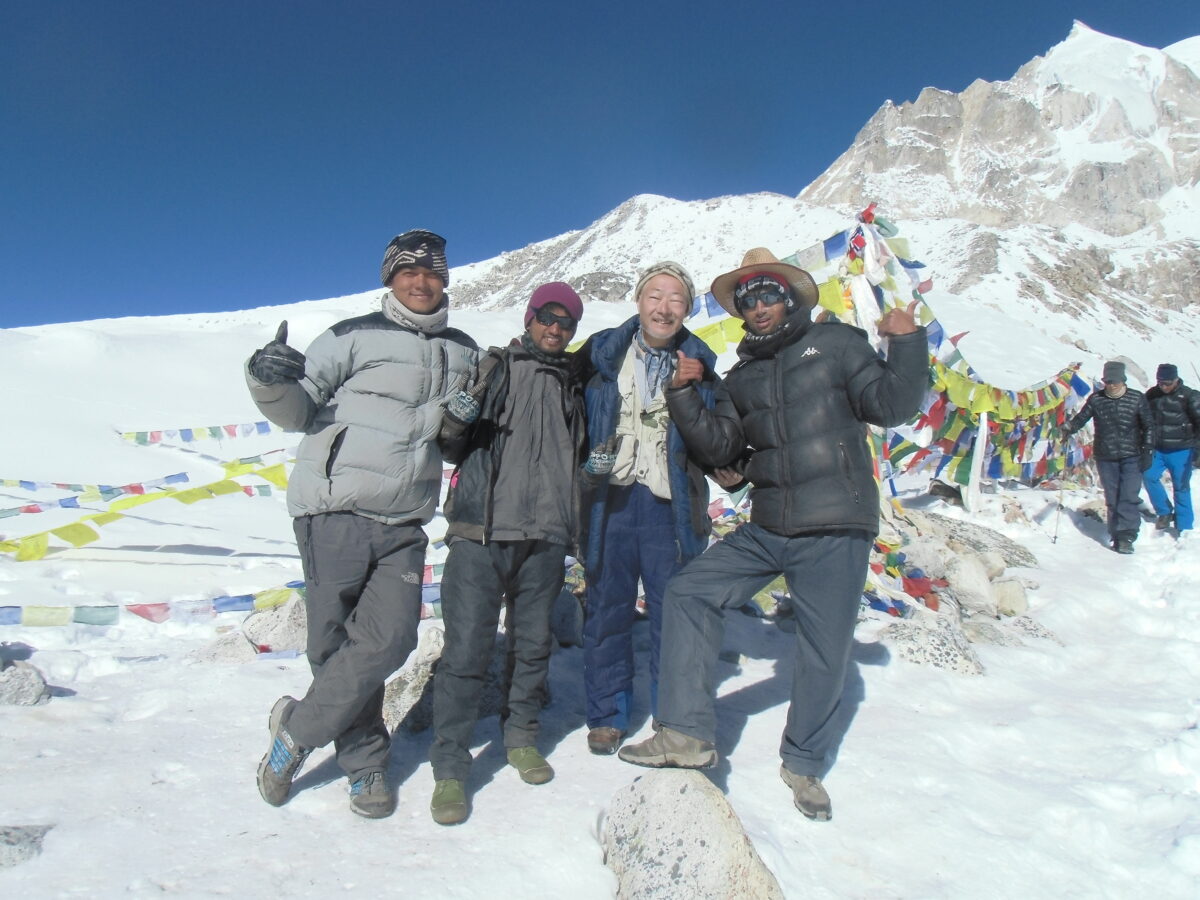
Autumn is also the peak trekking season for the Manaslu Circuit Trek. The skies turn crystal clear post-monsoon and display astonishingly beautiful, unobstructed vistas of the Himalayas. The temperatures are around 15 degrees Celsius to 20 degrees Celsius during the day in lower regions, while at night, it can dip down to beyond -5 degrees Celsius in the higher parts.
Usually, the trails are drier and more stable in Autumn, making it safer to walk on. This season also sees a cross-section of festivals like Dashain and Tihar, which adds to the vibrancy of culture. The combination of crisp mountain air and bright landscapes goes with that festive feel, giving trekkers the ultimate trekking experience in Nepal.
Is the Manaslu Circuit Trek Suitable for Beginners?
Yes, beginners can absolutely trek the Manaslu Circuit, provided they are reasonably fit and well-prepared. While it’s more remote and challenging than popular trails like Everest Base Camp or Annapurna, it’s still accessible to first-time trekkers who are committed to training and following basic trekking best practices.
On average, you’ll walk 15 to 18 kilometers per day across varied terrain from steep ascents to suspension bridge crossings. Beginners should ideally be regular walkers, gym-goers, or involved in cardio training before attempting this trek. With the right mindset and preparation, the Manaslu Circuit Trek can be an unforgettable first Himalayan adventure.
Essential Tips for Beginners on the Manaslu Trek:
- Take small, steady steps conserving energy is key on long climbing days.
- Stay well-hydrated by drinking 4 to 5 liters of water per day to help with acclimatization.
- Don’t rush proper acclimatization is more important than speed.
- Avoid alcohol and excessive caffeine, especially at higher altitudes.
- Eat well and carry energy bars or snacks to keep your stamina up throughout the day.
- Pack wisely bring all essential clothing and gear for the season, but avoid overpacking, as it will weigh you down.
At Mountain Treks Nepal, we offer full guidance and personalized support for first-time trekkers, including gear checklists, acclimatization schedules, and local insights to help beginners succeed safely and confidently.
Is Manaslu Dangerous? Understanding the Death Rate
Mount Manaslu, standing at 8,163 meters, is often referred to as one of the world’s more dangerous 8,000-meter peaks, earning the nickname “The Killer Mountain.” This refers to the summit climb, not the Manaslu Circuit Trek. The summit of Manaslu has seen a historical mortality rate of around 15% in earlier decades, though this rate has dropped in recent years with improved equipment, forecasting, and expedition logistics. Some sources cite even higher fatality rates during the peak’s earlier exploration years, especially during avalanches and unstable weather.
However, it’s important to distinguish this from the Manaslu Circuit Trek, which is a well-established, guided trekking route. It does not involve climbing the summit and is considered safe for healthy, properly acclimatized trekkers. With experienced guides, proper acclimatization, and attention to altitude sickness prevention, the trek can be completed safely by trekkers of varying experience levels.
At Mountain Treks Nepal, we prioritize safety above all else with trained guides, emergency preparedness, and expert support throughout your journey.
Travel Insurance for Manaslu Circuit Trek
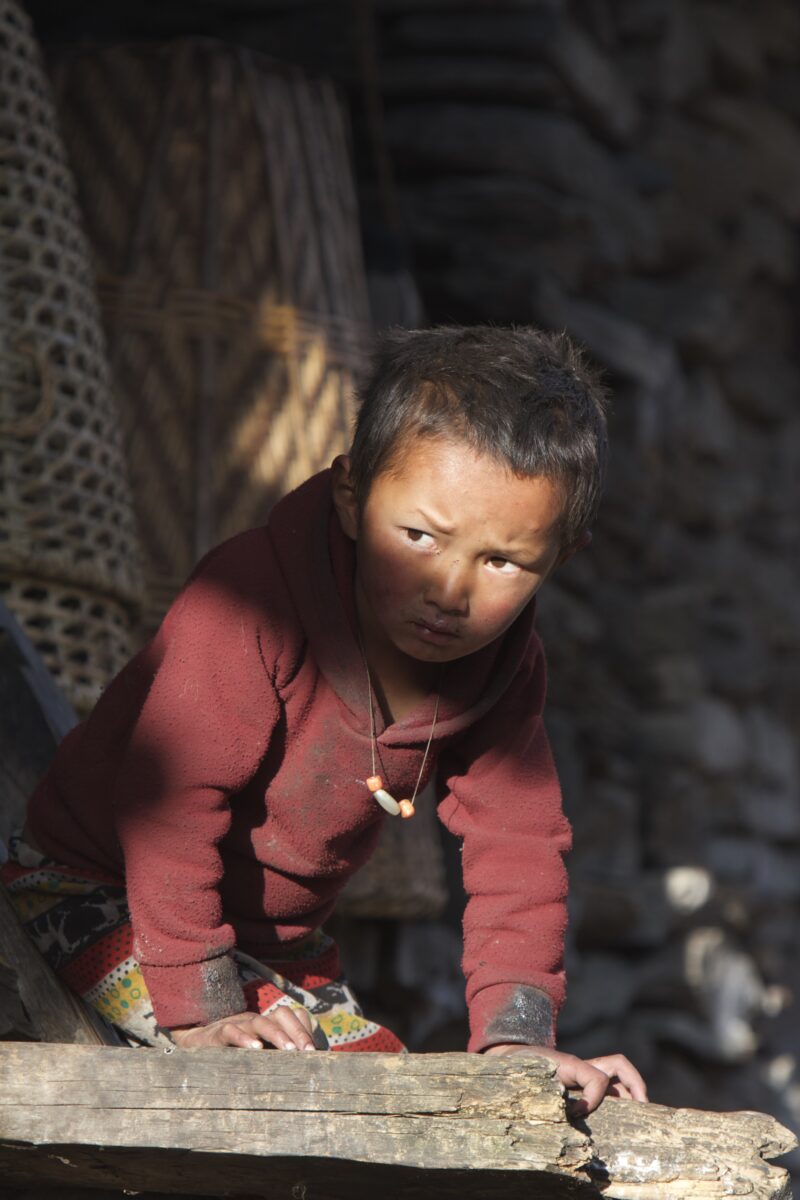
It is basically advisable to obtain travel insurance while going on the Manaslu Circuit Trek. After all, round manaslu trek is really remote and difficult to trek. Complete medical emergencies, helicopter evacuations and trip cancellations should be part of the insurance coverage as health posts are scarce, with very serious conditions needing airlift.
You can purchase travel insurance from several companies like MetLife, Allianz, Geo Blue and Seven Corner Travel Insurance.
What Is a Day on the Manaslu Circuit Trek Actually Like?
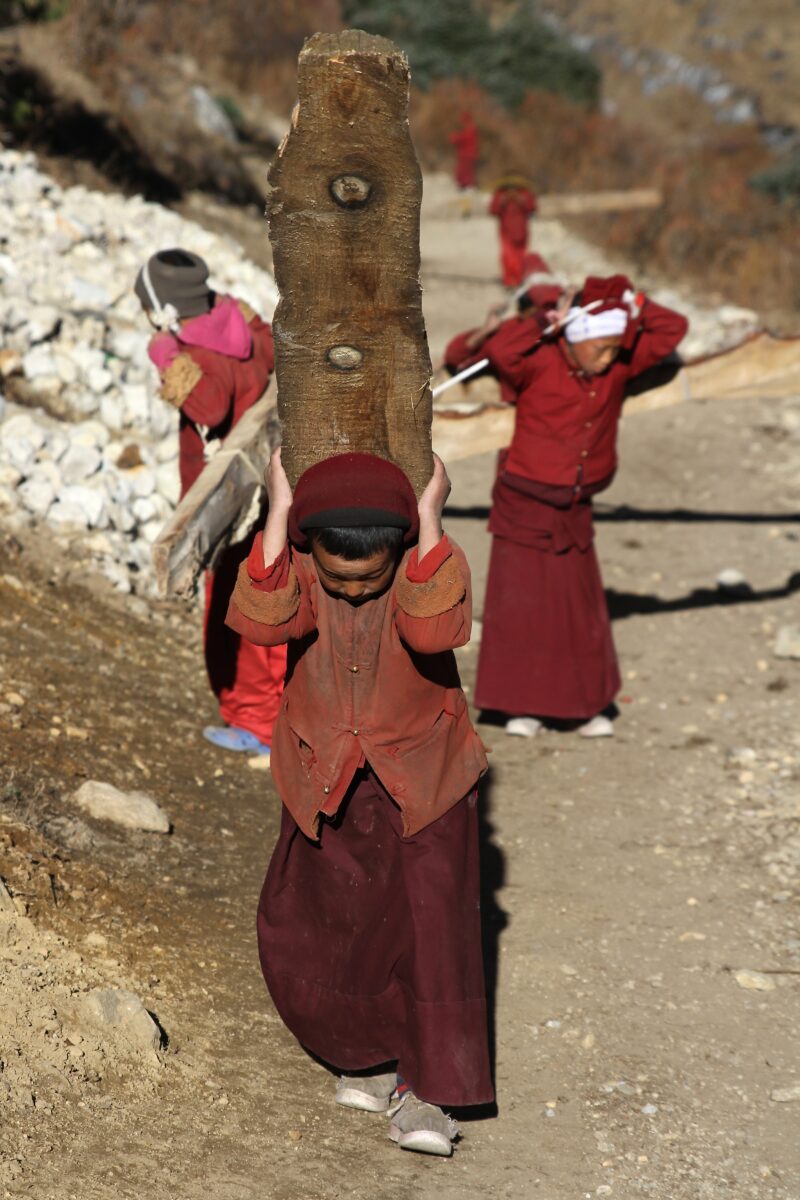
If you’ve done a high-altitude trek before, you’ll recognize the rhythm. But if this is your first time in the Himalayas, here’s a real look at what a typical day on the Manaslu Circuit Trek feels like.
Each day starts early. You’ll usually wake up around 6:00–6:30 AM in your teahouse room. After freshening up, a warm breakfast is served between 7:00 and 8:00 AM, often including items like Tibetan bread, porridge, or eggs. By 8:00 AM, you’ll hit the trail, following your guide through a mix of scenic forests, steep ridges, suspension bridges, and small villages.
As you trek, the guide sets the pace but if you’re feeling tired, just let them know. Breaks are frequent and relaxed, giving you time to catch your breath, hydrate, and enjoy the landscape. By midday, you’ll stop for lunch at a teahouse along the route. Meals are freshly prepared and usually take about an hour, giving you a chance to recharge before the afternoon stretch.
Post-lunch, you’ll trek for a few more hours depending on the itinerary, the weather, and the distance between villages. Most days end between 3:00 PM and 6:00 PM, when you reach your destination for the night. Your guide will help you settle into a teahouse, and the evening is yours to rest, journal, play cards, chat with fellow trekkers, or enjoy a hot meal.
You’ll want to keep a few essentials in your daypack water, snacks, energy bars, sunscreen, and a warm layer as conditions can shift quickly in the mountains. While the trek gets more challenging with altitude, the sense of accomplishment and the breathtaking views make every day worth it.
This rhythm becomes part of the adventure a mix of challenge, simplicity, and awe that defines the Manaslu Circuit experience.
After the Manaslu Trek: How to Unwind and Recharge
While the Manaslu Circuit Trek is an unforgettable adventure that refreshes the soul, it can leave your body feeling worn out. After days of long walks, high altitude, and cold mountain air, some post-trek recovery is well deserved.
Once you’re back in Kathmandu, consider treating yourself to a full-body massage or spa session something many trekkers find incredibly helpful for relieving muscle soreness. For women (and men, too), a little self-care like a facial or hair treatment can be a refreshing way to reset before heading home.
Give yourself at least one or two days to rest after the trek. If you’re feeling energized enough to explore, short cultural tours around Kathmandu Valley including visits to Bhaktapur, Patan, or Boudhanath are a great way to wrap up your Nepal experience without putting more stress on your legs. Another popular option is a day trip to Nagarkot, where you can enjoy panoramic Himalayan views without the hiking boots.
Taking time to relax and reflect after your trek not only helps your body recover but also gives you a chance to fully absorb everything you’ve experienced on the trail.
Where Can I Meet Mountain Treks Nepal?
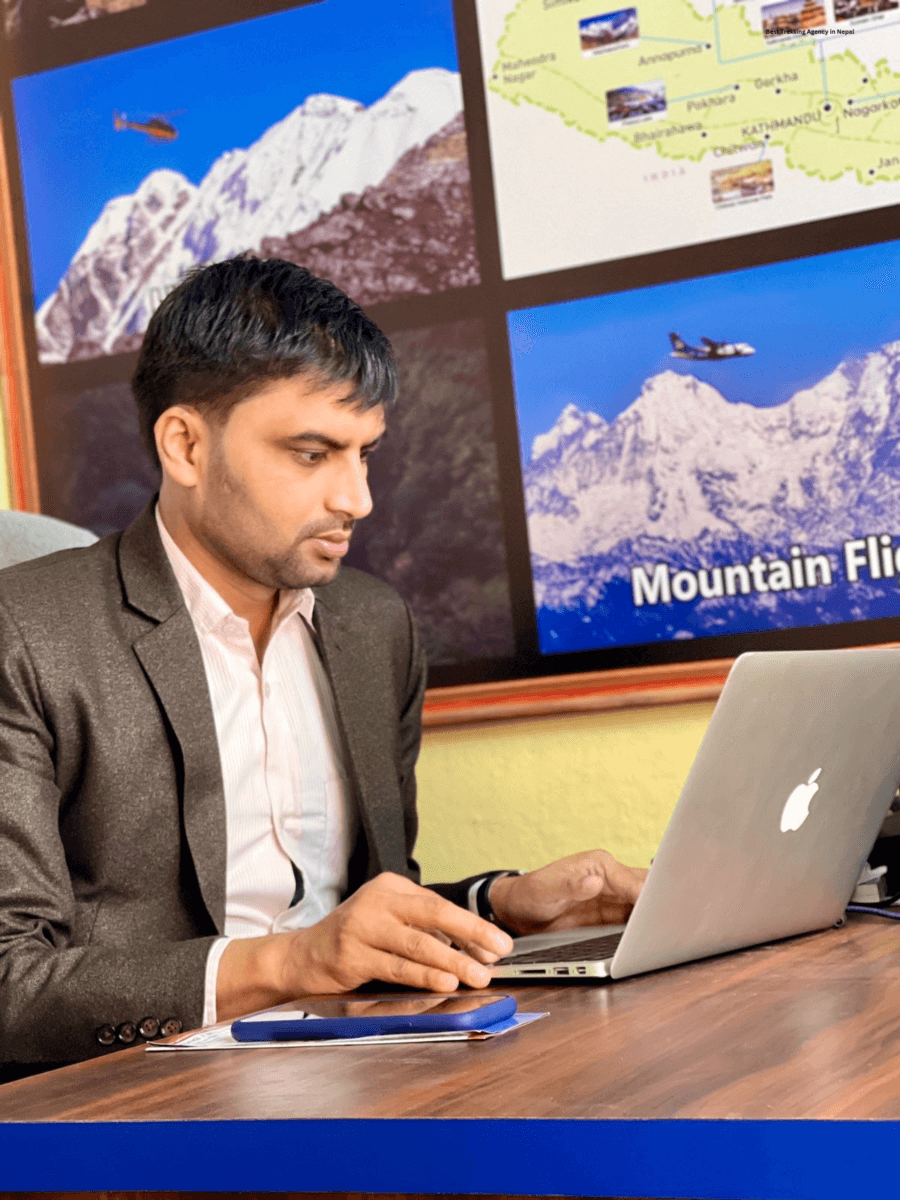
Getting in touch with Mountain Treks Nepal is easy. You can contact us directly via email or WhatsApp our contact information is available on our website. Once you’ve confirmed your booking, we’ll be ready to meet you at Tribhuvan International Airport in Kathmandu and provide a comfortable private transfer to your hotel.
Please note: while our trek package officially begins on the departure day from Kathmandu to the Manaslu region, accommodation before or after the trek is not included. However, if you are already in Kathmandu, just let us know your hotel, and we’ll arrange your pickup from there as part of our pre-trek support.
At Mountain Treks Nepal, we value flexibility and clear communication. Before your arrival, we’ll send you the contact details of your guide and airport driver, so you’ll always know who to reach out to if you have any questions or last-minute concerns.
Booking and Payment with Mountain Treks Nepal
Booking your Manaslu Circuit Trek with Mountain Treks Nepal is simple, secure, and fully supported from start to finish. To get started, reach out to us via our website, email, or WhatsApp to express your interest and preferred trekking dates.
Once we hear from you, we’ll provide a detailed itinerary, pricing breakdown, and package inclusions so you know exactly what to expect. After confirming your trek, we’ll request a deposit to begin processing your permits and logistics. The balance can be paid before or upon arrival in Kathmandu using secure methods such as bank transfer or trusted online payment gateways.
Before your trek begins, we’ll hold a pre-departure briefing, either online or at our Kathmandu office, to review any remaining questions, finalize gear checks, and walk you through the day-to-day itinerary. On the day of departure, your guide and our support team will meet you at the starting point, fully prepared to make your journey through Manaslu’s landscapes and cultures both safe and memorable.
Electricity on the Manaslu Circuit Trek
Yes, you can access electricity on the Manaslu Circuit Trek, but it’s limited and not always reliable especially at higher elevations. Since the trail runs through remote Himalayan villages, power supply is inconsistent, and many areas rely on solar energy, particularly above 3,500 meters.
In most teahouses along the lower and middle sections of the trek, you’ll be able to charge your phone, camera, or power bank but this typically comes at an extra cost. Depending on the altitude and location, charging fees range from NPR 300 to NPR 700 per device (approximately USD 2.50 to 6).
One important note: Dharmasala, the final stop before crossing Larkya La Pass, does not have any electricity at all. There are no charging facilities, and even basic lighting is minimal. This makes it essential to carry fully charged power banks or extra batteries before reaching that point.
In general, we recommend:
- Carrying a solar charger or high-capacity power bank
- Turning on battery saver mode on your devices
- Charging electronics during daylight hours when solar power is most available
While power access may be limited, with some preparation, you’ll stay connected and powered throughout most of your Manaslu adventure.
Drinking Water during Manaslu Circuit Trek
Some safe options for drinking water include boiling, purification tablets, and bottled water. Filling bottles from natural sources is the most prevalent method but requires some purification.
Communication and Internet Services
While the Manaslu Circuit Trek is remote, basic communication services are available along much of the route. Most teahouses offer telephone services for an additional fee, allowing you to stay in touch with friends and family if needed.
Mobile coverage is generally reliable in the lower and mid-altitude villages, particularly through the Nepal Telecom (NTC) network. However, as you ascend to higher elevations especially near Samdo, Dharmasala, and Larkya La Pass network signals can become weak or disappear entirely.
Some teahouses also provide Wi-Fi, though the connection may be slow and come with a small charge. For many trekkers, Wi-Fi becomes the most practical option when mobile service is unavailable.
Before you start your trek, we recommend purchasing a Nepali SIM card (NTC preferred) in Kathmandu. The process is simple just bring two passport-sized photos and a copy of your passport to any authorized telecom outlet. Having local data can help you check maps, weather forecasts, or communicate with your guide and support team during the lower sections of the trek.
Currency Exchange
If you’re arriving in Nepal without Nepali currency, don’t worry money exchange is easy and accessible, especially in Kathmandu. The exchange rate for USD to NPR (Nepalese Rupee) fluctuates daily, so it’s best to check current rates upon arrival.
The best place to exchange money is in Thamel, Kathmandu’s main tourist hub, where you’ll find dozens of money exchange centers offering competitive rates. Be aware that the money exchange counters at Tribhuvan International Airport often charge higher fees or offer less favorable rates, so it’s better to exchange only a small amount at the airport and handle the bulk of your exchange in the city.
Once you begin the Manaslu Circuit Trek, access to currency exchange disappears. That’s why it’s essential to carry enough Nepali rupees with you for the entire trek. Teahouses, lodges, and local shops along the trail only accept Nepali currency, and there are no ATMs after leaving Kathmandu or Pokhara.
For a smooth experience:
- Exchange your money in Kathmandu before the trek
- Carry small denominations for easier transactions in remote villages
- If using ATMs, withdraw in advance and avoid relying on them in the days leading up to your trek
Being financially prepared ensures a hassle-free trekking experience and supports local businesses that rely on cash transactions.
Food on the Manaslu Circuit Trek
While in Kathmandu, your meals are mostly on your own breakfast is included, along with a welcome or farewell dinner provided by Mountain Treks Nepal. This gives you the freedom to explore the city’s wide range of restaurants and cuisines. However, once the Manaslu Circuit Trek begins, all three meals per day are included as part of your trekking package.
The food served in teahouses along the trail is fresh, wholesome, and designed to fuel long hours of trekking. Breakfast usually includes options such as porridge, Tibetan bread, pancakes, muesli, toast, eggs (boiled, scrambled, or as an omelette), oats, and hot drinks like tea or coffee. It’s simple but energizing, perfect for a mountain morning.
Lunch and dinner options tend to be similar and include a mix of Nepali, Tibetan, and basic Western dishes. The staple and most popular choice is Dal Bhat, a traditional Nepali meal made of rice, lentil soup, vegetables, and sometimes meat, with unlimited refills. Other options include fried noodles, thukpa (noodle soup), pasta, momos (Nepali dumplings), fried rice, chow mein, sandwiches, and seasonal vegetable or meat curries. Garlic soup is also popular at higher altitudes as it’s believed to help with acclimatization.
Though menus may vary slightly from one village to the next, the food is generally filling, nutritious, and well-suited for the high-energy demands of the trek. If you have dietary restrictions or food allergies, just let us know in advance we’ll communicate with the teahouses to accommodate your needs.
People of the Tsum Valley
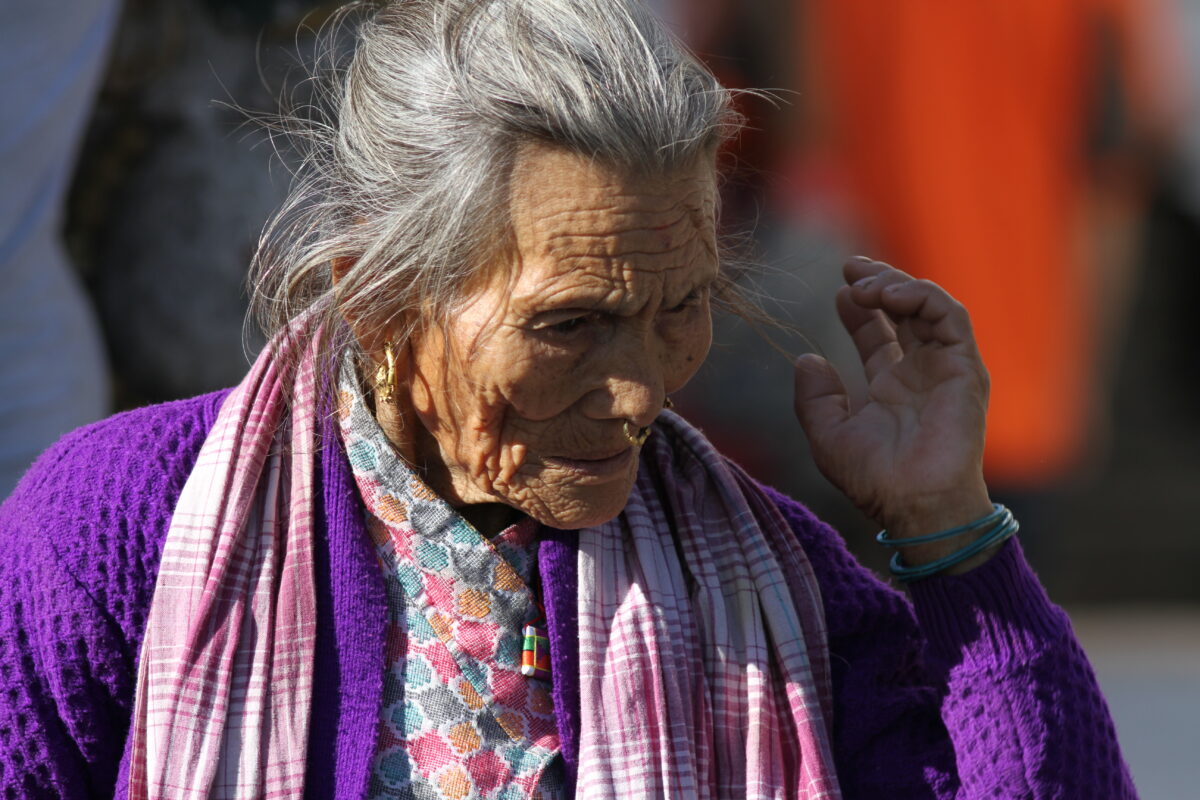
When you extend your Manaslu Circuit Trek to include the Tsum Valley, you enter a truly remote and culturally distinct part of Nepal. The valley is home to the Tsumbas, an ethnic group of Tibetan origin with a population of around 2,700 people, most of whom rely on subsistence farming and animal husbandry for their livelihood.
The Tsumbas speak their own unique language, known as Tsumke or Tsumba, and live in villages that have remained largely unchanged for generations. Isolated from modern development until fairly recently, their customs and way of life offer a rare glimpse into the preserved traditions of Tibetan Buddhist culture.
Local folklore is rich in legend, and many residents claim to have seen the mythical Yeti in the surrounding mountains. Whether myth or mystery, these stories add a layer of mystique to the region. One of the most unique aspects of Tsumba society is the continued practice of polyandry a tradition where a woman may marry multiple brothers in the same family. Though uncommon in the modern world, it persists here as part of the community’s cultural fabric and historical way of managing land and resources in this high-altitude environment.
A trek through the Tsum Valley is not just a physical journey it’s a cultural and anthropological exploration into a world that feels untouched by time.
Tipping Culture on the Manaslu Circuit Trek
While tipping is not mandatory in Nepal, it is a common and appreciated practice, especially on treks like the Manaslu Circuit, where your guides and porters play a crucial role in your experience. These team members work tirelessly carrying gear, managing logistics, and ensuring your safety and comfort at high altitudes.
Whether you’re part of a group or trekking privately, your guide and porter are your closest companions on the trail, and a tip is a meaningful way to recognize their effort, professionalism, and support.
There’s no fixed amount for tipping it’s completely at the discretion of the trekker. However, most travelers choose to offer a tip based on the quality of service and their overall experience. A small gesture of gratitude goes a long way, and exceptional service can be acknowledged with a more generous amount.
At Mountain Treks Nepal, we encourage trekkers to tip fairly and thoughtfully, as it helps support the hardworking individuals who make these treks possible. If you’re unsure about how much to tip, feel free to ask us we’re happy to provide guidance based on local norms.
Culture and Festivals of the Manaslu Region
The Manaslu region is one of Nepal’s most culturally rich and diverse trekking areas. As you ascend through different altitudes, you’ll also journey through distinct cultural landscapes shaped by centuries of history, religion, and tradition.
In the lower villages, you’ll encounter communities of Chettri, Brahmin, and Newar heritage, where daily life is deeply rooted in Hindu traditions. These areas offer a glimpse into Nepal’s more mainstream cultural fabric, with terraced farming, traditional homes, and Hindu temples.
As you move higher into the upper Manaslu Valley, the cultural atmosphere shifts dramatically. Here, you’ll find Tibeto-Burman and Mongoloid ethnic groups such as the Rai, Magar, Gurung, and Tamang, who live according to Buddhist customs and Tibetan-inspired traditions. The villages are adorned with colorful prayer flags, mani walls, stone chortens, and spinning prayer wheels that reflect deep spiritual devotion.
The region is dotted with historic monasteries, including Mu Gompa, Gumba Lungdung, and Rachen Gompa, where you can witness monastic life in action. These gompas are home to monks and nuns many of them young who are engaged in meditation, traditional Tibetan medicine, and scriptural study.
Festivals are an integral part of life in the Manaslu region. Lhosar, the Tibetan New Year, is one of the most significant celebrations, marked by prayer, dance, music, and colorful attire. Another key celebration is Buddha Jayanti, which commemorates the birth of Lord Buddha and is observed with joy, rituals, and community gatherings.
Trekking through Manaslu offers not only stunning scenery but also a rare cultural immersion, where travelers can engage with ancient traditions, admire distinctive highland clothing, and perhaps even participate in local festivals if the timing is right.
Local Dress and Cultural Etiquette on the Manaslu Trek
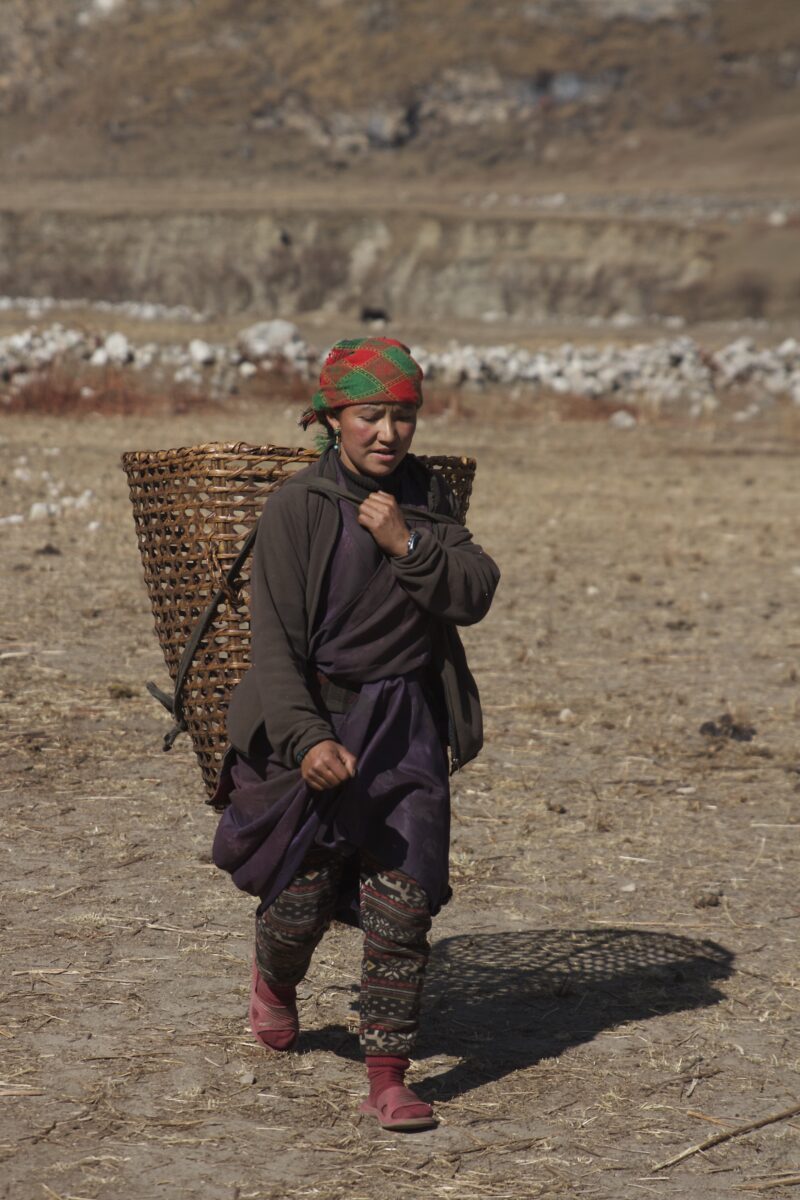
Nepal is a richly diverse country, home to many ethnic groups, each with its own traditions, languages, and clothing styles. When trekking through the Manaslu region, you’ll encounter Tibetan-influenced mountain communities whose traditional dress and customs are an important part of the cultural experience.
In the high Himalayas, locals typically wear thick, warm clothing suited to the cold climate. Two traditional garments you’ll often see are the Bakhu, a long woolen wrap dress, and the Docha, sturdy woolen boots. These clothes not only reflect cultural heritage but are also practical for mountain life.
As a visitor, it’s important to dress modestly and respectfully. While there’s no formal dress code for trekkers, it’s best to avoid shorts or revealing clothing both out of cultural respect and for practical reasons, such as cold weather or protection from insects. Wearing long sleeves and layers is more appropriate and appreciated in village areas.
Another custom to be mindful of is the removal of shoes before entering homes or certain sacred spaces. While this may not be required in every teahouse or lodge, it’s a common gesture of respect in private homes and monasteries.
At Mountain Treks Nepal, we always encourage responsible and culturally sensitive trekking. Respecting local dress and customs helps create a positive connection with the communities that welcome us into their villages and homes.
How Much Cash Should You Carry on the Manaslu Circuit Trek?
Most of your essential expenses meals, accommodation, permits, guide and porter services, and transportation are already covered in your trekking package with Mountain Treks Nepal. However, you should still carry some extra cash for personal expenses along the way.
Expect to pay out of pocket for things like snacks, hot drinks, Wi-Fi, charging electronics, hot showers, and tips for your guide and porter. Additionally, you may want to buy small souvenirs or contribute to monasteries and local initiatives along the trail.
We recommend carrying around USD 200 to 300 (or the equivalent in Nepali rupees) for the full trek. ATMs are not available once you leave Kathmandu, so it’s important to withdraw and exchange currency before starting the trek.
As a rule of thumb, always carry small denominations for easier transactions in remote villages where change may not be readily available.
Extending the Manaslu Circuit Trek: Add the Tsum Valley
If you’re looking to deepen your Himalayan experience, the Manaslu Circuit Trek can be easily extended by adding the Tsum Valley, one of Nepal’s most sacred and culturally rich trekking routes. While the standard Manaslu Circuit takes about 13 days, including Tsum Valley adds 6 to 7 more days, transforming the trek into a more immersive three-week adventure.
The Tsum Valley often called the “Hidden Valley” was only opened to trekkers in 2008 and remains largely untouched by modern development. Nestled near the Tibetan border, this remote region is home to ancient Buddhist monasteries, traditional stone villages, and a strong Tibetan cultural heritage. It offers a rare chance to witness Himalayan life that has remained unchanged for centuries.
Trekkers who combine the Manaslu Circuit with the Tsum Valley will follow a slightly different route, usually branching off from Lokpa before reconnecting with the main circuit near Deng or Philim. The detour is increasingly popular, especially during peak trekking seasons in spring and autumn, and is highly recommended for trekkers with extra time and a deeper interest in local culture and spirituality.
If you’re interested in extending your Manaslu adventure, Mountain Treks Nepal can fully customize the itinerary, permits, and logistics for a seamless Tsum Valley extension.
Full Manaslu Trek Route (Key Stops)
Kathmandu → Naubise → Maklekhu → Dhading Besi → Jyamire → Gola Bhanjyang → Aarughat → Soti Khola → Machha Khola → Khorla Besi → Tatopani → Dovan → Thulo Dhunga → Jagat → Salleri → Philim → Chisapani → Deng → Bhee Phedi → Ghap → Namrung → Sho → Lho → Shyala → Pungyen Gompa → Samagaon → Birendra Lake / Manaslu Base Camp → Samdo → Tibetan Border (optional) → Larkya Bazaar → Dharmasala → Larkya La Pass → Larke Phedi → Bimthang → Yak Kharka → Sokhe → Goa → Tilje → Besisahar → Dhading → Kathmandu
This detailed route showcases everything from lush lowlands and traditional villages to alpine meadows and high-altitude mountain passes. The crown jewel of the trek is Larkya La Pass (5,106 m) a thrilling crossing with panoramic views of Himlung Himal, Cheo Himal, Kang Guru, and Annapurna II.
Mountain Treks Nepal can customize this route based on your schedule, interests, and fitness level, including side trips to Manaslu Base Camp, Pungyen Gompa, or even a detour into the Tsum Valley.
Alternative Treks Around the Manaslu Region
While the Manaslu Circuit Trek is the most well-known adventure in the region, there are several lesser-known but equally rewarding alternatives for those seeking more remote trails or added cultural experiences.
Popular alternative treks around Manaslu include:
- Tsum Valley Trek – A secluded spiritual journey into Tibetan-influenced villages, monasteries, and untouched landscapes.
- Rupina La Pass Trek – A remote and challenging route that passes through pristine wilderness, ideal for seasoned trekkers.
- Manaslu & Annapurna Circuit Combined Trek – A longer and more comprehensive route that links two of Nepal’s greatest treks.
- Manaslu Circuit + Tsum Valley Trek – A perfect blend of high-altitude challenge and cultural immersion.
These alternative treks can be customized based on your time, fitness, and trekking goals by Mountain Treks Nepal.
Conclusion
The 14 Days Manaslu Circuit Trek in Nepal brings about a call for adventuring souls with a combination of landscapes, cultures, and physical challenges. Round Manaslu Trek rewards are showcased with magnificent views from Mount Manaslu and the surrounding peaks.
Along the way, discover beautiful traditional villages and experience the Gurung and Tibetan communities closer. Crossing the high Larkya La Pass of (5,106m) and getting into the colourful culture of the place by spending some time with the very warm and welcoming locals. You can go through our Short Manaslu Circuit Trek of 8 Days and Tsum Valley Trek packages and plan for your next trip in Manaslu Region, Nepal with Mountain Treks Nepal.
Trip Highlights
- A challenging but rewarding trek through the stunning Manaslu region of the Himalayas
- Breathtaking views of Manaslu (8,156 meters) and other peaks
- A variety of landscapes, including forests, meadows, waterfalls and high-altitude passes
- An opportunity to learn about the local culture and way of life in traditional villages
- A chance to spot wildlife, including Himalayan thar and blue sheep
- A trek that takes 12-16 days to complete, depending on the route and pace
- Involve into the amazing unique culture, tradition of Nepalese influenced by Tibetan culture
- Lovely alpine, juniper and also rhododendron forests
- Crossing of Larkya La Pass (5,106 meters), which draws out breathtaking panoramic views.
Trip Route

Have a Question? Inquire Now
Why Mountain Treks Nepal?
- Expert Team for Unparalleled Experience
- Best Price Guarantee
- Safety is the first Priority
- Easy Booking & Secure Online Payment
- Flexible And Personalized Service
- 24/7 Support
- Highest Satisfaction Guaranteed
- Highly Experienced Guides
- Your Satisfaction is Our Guarantee
- One-time Deposit, Assured for a Life Time
Detailed Itinerary
As you arrive at Tribhuvan International Airport, a representative from Mountain Treks Nepal will meet you and take you to your hotel. Once you check-in, you can sit back, freshen up, and unwind after traveling.
In the evening, a short briefing will be provided to you with an introduction to your trek plan and important guidelines. As a preparation for the thrilling journey ahead, you can then enjoy the lively streets of Thamel or spend a quiet evening. Overnight in Kathmandu.
From picturesque Kathmandu, the real adventure begins as you drive through lush countryside and hilly terrains. The drive will take you through the lush green forests and the Trishuli river alongside. After a short hour of driving, you will first reach Arughat Bazar.
After passing Arughat Bazar, which is quite busy in the Budhi Gandaki Valley, the drive offers admission into all its tributaries-an insight into the rural life of Nepalese people. It is thus a 7 to 8 hr drive journey, which finally ends on the quiet riverbank village of Machha Khola.
It’ll be a lodge for you to spend a night at, enjoying the excellent tranquility of the hills and rivers all around. Stay overnight at Machha Khola.
On the second day of 14 Days Manaslu Circuit Trek, you will hike to Jagat from the beautiful village of Machha Khola. Today’s hike takes you through beautiful bamboo and rhododendron forest. Occasionally, the path makes a high ascent up over the Budhi Gandaki River, giving spectacular views of one of the most magnificent deep gorges and rushing waters.
The valley opens further and further with the surrounding landscape as well as the path gets wider and attractive until reaching the village of Jagat. Jagat is known for its traditional stone-paved streets and another cozy stop where one can spend the night at a tea house. Overnight in Jagat.
Today’s journey begins at the village of Jagat and ends at Deng. The journey to Deng will lead you through terraced hillsides that are dotted here and there with small settlements. You can cross the suspension bridges that are made up of phenomenal landscapes and wonderful vegetation.
Further, the trail climbs up to the Gurung village of Deng, which is an ideal place to appreciate an amazing view of the Shringi Himal. This wonderful site has immersed itself in local culture, and one can spend a night at a tea house in Deng.
Today, the trail runs along the Budhi Gandaki River, crossing over many times. You will first reach Ghap, a beautiful Buddhist village with mani walls and prayer flags. Here, you can get insights into Tibetan Buddhism and its practice.
After walking the ups and downs through dense and quiet forests, you will come to Namrung, a bustling settlement with a checkpoint for entering permits. It has some spectacular views of the peaks surrounding it, as well as a cozy lodge for rest. Overnight in Namrung.
The sixth day of the 14 Days Manaslu Circuit Trek will wind up from Namrung to Lho village. As you ascend, the world of alpine landscapes will open up for you along the trail to Lho. You will enjoy the sights of mighty peaks such as Mount Manaslu and Sringi Himal as you walk past the rhododendrons and pine trees. There, you will find your first views of Manaslu North and the surrounding peaks.
Lho is a typical Tibetan village with stone houses and a nice monastery. It is a good place to come and drink in silence while gazing up at the great mountains. Overnight in Lho.
Today’s hike will undoubtedly be a visual feast as it takes you to the peaks of the Kutang Himal to the northeast and the magnificent Manaslu to the southwest before stopping by an enchanting little village called Shala on the way to Sama Gaun.
Sama Gaun is indeed a melting pot of culture with impressive Gompa and excellent views of the Manaslu. It is ideal for unwinding and roaming around after checking into a lodge. Spend the night in Sama Gaun.
Today is the day for acclimatization. We will acclimatize to preparing for higher elevations. You will hike up to some of the nearby viewpoints or absorb the cultural heritage of Sama Gaun.
The village gives insight into the traditional Tibetan life from the monasteries, chortens, and even stone walls. Let this time be for you to relax and let your body adapt to the altitude. Overnight stay in Sama Gaun.
On the ninth day of the 14 Days Manaslu Circuit Trek, we will reach Samdo, one of the high-altitude locations in Manaslu Region. The travel between Sama Gaun and Samdo is short yet soulful. You will trek across the lush alpine meadows and move up a gentle path flanked by towering peaks.
Samdo, being a Tibetan influenced village, offers itself as a beautiful, calm place for interacting with the locals. This is a perfect acclimatization point and even better, the base for further explorations. Overnight stay at Samdo.
This day will take you from Samdo to Dharmasala. The path climbs higher and higher, through some wild, savage terrain, to the old trade route with Tibet. The last climb is not the steepest, but it surely pays for itself with some breathtaking views of the majestic Himalayas.
Dharmasala, or Larkya Phedi, serves as the base for Larkya La Pass. You will be accommodated in basic accommodation at a tea house in Dharamsala.
Today is the most difficult and rewarding phase of the 14 Days Manaslu Circuit Trek. The trail leading to Larkya La Pass would give a sweeping view of the Himalayas, which include Manaslu and Annapurna.
The scenery opened up on crossing the pass before the trail descends into Bimthang, with beautiful meadows surrounding the settlement. Celebrate this achievement and enjoy a nice, peaceful evening at a cozy lodge. Overnight in Bimthang.
The trail we catch from today will start descending from today as we head towards Dharapani. Further descending from Bimthang, we will pass through the colored villages Kharche, Gho, and Tilje, surrounded by terraced fields among wooded hills. The main trail then joins the famous Annapurna Circuit trail.
This great bustling village of Dharapani has better amenities, making it an excellent stop to take a breather with thoughts about your journey. Overnight stay in Dharapani.
This is the last day of the 14 Days Manaslu Circuit Trek. Today, the route drags its way through a rugged drive down to Besisahar. The rest of the journey continues on the road and ends up in Kathmandu.
Upon reaching Kathmandu, you will be escorted to your respective hotel where you will stay overnight.
On this day, you will depart from Nepal after completing the beautiful 14 Days Manaslu Circuit Trek. Our representative will escort you to Tribhuvan International Airport, where you must attain the legal formalities before boarding a flight to your home country.
Trip Includes
- 14 days Trips, 12 of which included 3 meals a day (Breakfast, Lunch and Dinner) during the trek.
- Airport pickup and drop by private vehicle .
- Accommodation during the trekking.
- Two nights’ accommodation in Kathmandu with Breakfast.
- A cup of tea every morning during the trekking.
- Kathmandu to Machhi khola and Dharapani to Kathmandu ground transportation by Local Bus.
- An experienced English-speaking trek leader (trekking guide), assistant trek leader (8 trekkers: 1 assistant guide) and porters to carry luggage (2 trekkers:1 porter) including their salary, insurance, equipment, food and accommodation.
- Manaslu Conservation Entry Permit and Restricted area Permit.
- Annapurna Conservation Permits.
- Government taxes.
- Local Taxes.
- Sleeping bag, down jackets and duffel bag – if Necessary (Need to returned after the trek).
- Farewell dinner with Nepali culture show.
Trip Excludes
- Personal Travel Insurance.
- Nepal entry visa.
- International airfare.
- Drinks (mineral water, Tea, coffee, whisky) or other snacks and any meals beside breakfast, lunch and dinner. Hot shower, Battery charge, Wi-Fi charge etc.
- Tips for Guide and potter( Tipping is Expected).
- Personal expenses.
- Personal trekking equipments.
- Any others expenses which are not mentioned on the “Trip Includes” Section.
Departures Costs and Dates
Packing List For Manaslu Circuit Trek

General
- Four-season (zero degree) sleeping bag
- Sleeping bag liner
- Puffy down jacket
- Daypack (35-45 liters) with rain cover
Upper Body
- Warm Hat
- Sunglasses
- Scarf/Neck Gaiter/Buff (highly recommended)
Torso
- Moisture-wicking base layers
- Insulating layers (fleece jacket)
- Puffy down jacket
- Waterproof and windproof outer shell jacket
Lower Body
- Quick-drying trekking pants
- Thermal leggings (for high altitudes)
- Waterproof and windproof pants
- Sturdy hiking boots
- Moisture-wicking trekking socks
- Shorts (for lower altitudes or warmer days)
Hands
- Insulated gloves or mittens
- Liner gloves (for added warmth or dexterity)
- Waterproof outer gloves or mittens
- Hand warmers (optional, for extra cold conditions)
- Sunscreen (for protecting your hands from sunburn at high altitudes)
- Hand sanitizer or wet wipes
- Small repair kit (including duct tape for any handwear repairs)
Feet
- Tough hiking boots
- Trekking socks that wick away moisture
- Optional liner socks for increased comfort
(To prevent snow and debris out of your boots) gaiters - Foot warmers—optional in very cold climates
extra laces - Supplies for treating blisters
Medicines and First Aid Kits
- Personalized first aid kit
- Bandages and adhesive tape
- Antiseptic wipes
- Pain relievers
- Anti-diarrheal medication
- Altitude sickness medication
- Sunburn relief cream
- Cough Syrup
Other Equipments
- Passport and Documents
- Trekking poles for stability
- Water bottles or hydration system
- Water purification tablets or filter
- Lightweight towel and toiletries
- Sunscreen and lip balm with SPF
- Insect repellent
- Portable charger or solar charger
Frequently Asked Questions

In fact, with ethnic groups like the Nubri and Tsumba people living there who have Tibetan ancestry, the Manaslu region is rich in Tibetan culture and customs. You'll get the chance to go to monasteries, meet people, and see traditional rituals, offering a distinctive sense of cultural immersion.
Absolutely! The serene and remote environment of the Manaslu region provides the perfect setting for spiritual exploration and meditation. You can visit ancient monasteries, practice mindfulness in tranquil natural settings, and learn about Buddhist philosophy and meditation techniques from local monks.
There is a wide variety of plants and creatures in the Manaslu Conservation Area, including uncommon Himalayan species. You could come across beautiful meadows, mountain meadows, and pure rivers overflowing with life. As you walk through this pristine environment, keep a look out for animals like the elusive snow leopard, Himalayan blue sheep, and other bird species.
Yes, depending on the timing of your trek, you may have the opportunity to witness traditional festivals or cultural events celebrated by the local communities along the Manaslu Circuit Trek route. Experience the vibrant colors, music, dance, and rituals of these festivals, providing a unique insight into the local culture and traditions.
We prioritize sustainable tourism practices and responsible travel ethics. We collaborate with local communities to ensure that tourism benefits are distributed equitably and support initiatives such as education, healthcare, and environmental conservation in the Manaslu region.
Because of high elevations, difficult paths, and lengthy hours of walking, the trek is moderately difficult in nature. Trekkers need to have good physical fitness and endurance to cross the Larkya La Pass at an altitude of 5,135m. Proper acclimatization is necessary to avoid altitude sickness.
Yes, you will have to acquire the Manaslu RAP, MCAP, and ACAP permits to trek into the restricted and conservation areas. Without trekking permits, trekkers cannot take on the Manaslu Circuit Trek.
It may not be the ideal trek for beginners because of its high altitude, but very fit, highly motivated first-timers can do it. Hiring good, experienced guides and porters is very important for the effort.
You can obtain permits for this trek from Nepal Tourism Board in Kathmandu after submitting documents such as copies of passport, visa, photographs, and permit fees.
The best seasons are spring (March-May) and autumn (September-November). These months offer clear skies, moderate temperatures, and stunning mountain views. Winter can be harsh, and monsoon trails may become slippery and prone to landslides.
Teahouses, which have basic accommodations and meals, are a great part of the trail. Facilities are simplified at higher altitudes, but trekkers can enjoy the local Nepali and Tibetan meals like dal bhat and momos.
Yes, it is important to have a comprehensive travel insurance policy that covers medical emergencies and evacuation, as well as cancellation of trips. Insurance is necessary for safety concerns, especially in very remote places where medical institutions are not easily accessible.
It would help if you focused on building great fitness endurance stamina through aerobic and strength training before the trek. Proper gear with warm clothes and trekking boots, water purification equipment is also very important. Familiarize yourself with symptoms of altitude sickness as well as preventive measures.




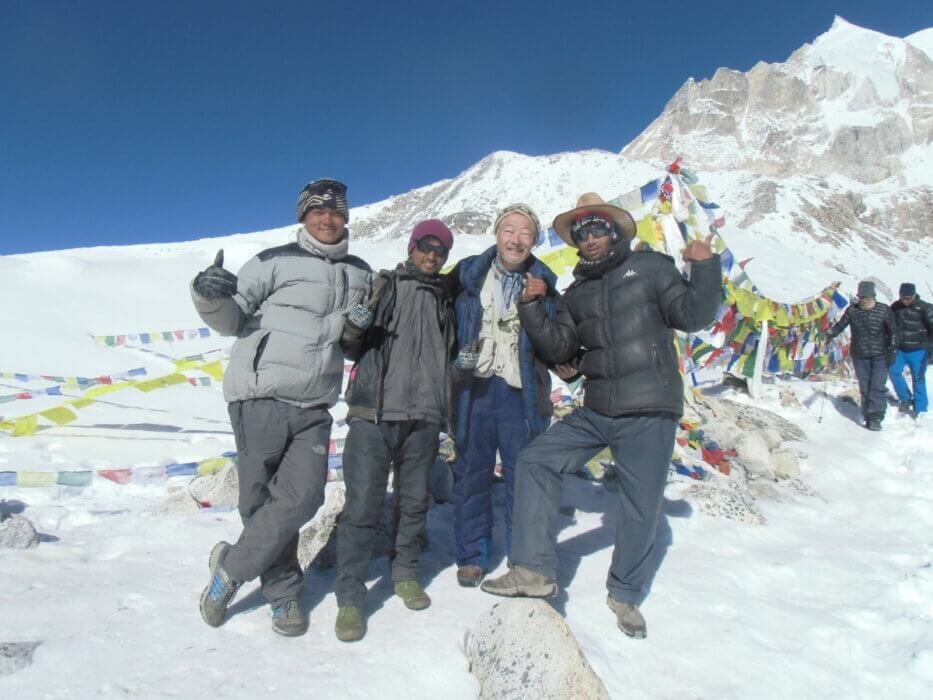
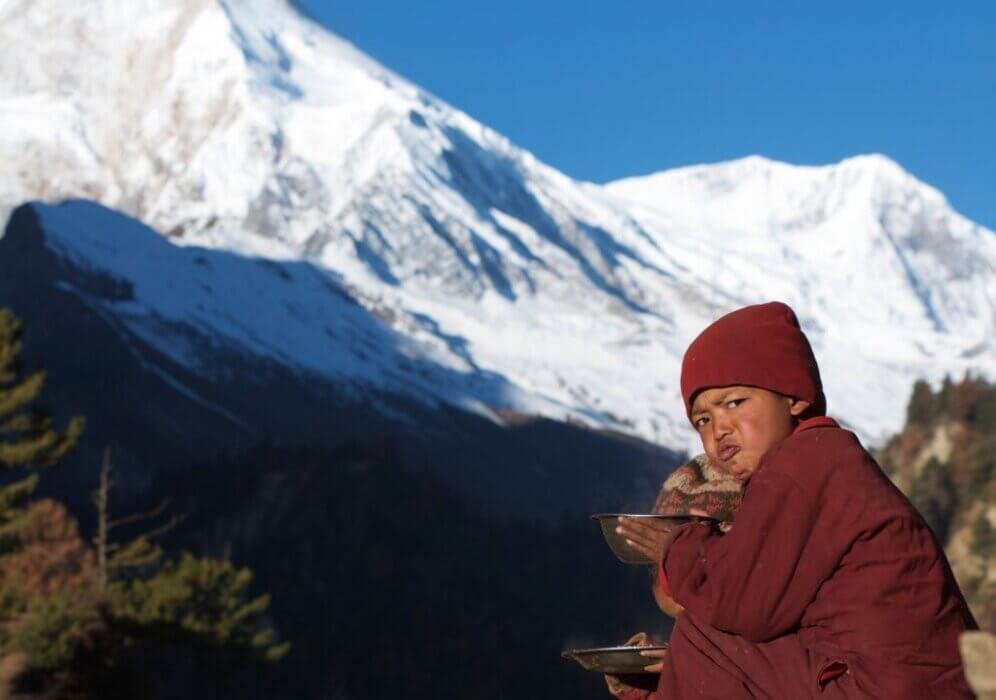
Rueben
May 17, 2025 at 1:38 pmSuperb Manaslu circuit trek
We had an unforgettable trekking experience with Mountain Treks Nepal! From the start, Bharat, the manager, was incredibly helpful—organizing everything smoothly and answering all our questions with care and professionalism.
Our guide, Bibak, was simply amazing. He’s knowledgeable, friendly, and passionate about the mountains. He kept us safe, motivated, and made the trek fun with his stories and great energy. He even helped us take some fantastic photos and introduced us to local culture and food.
The scenery was breathtaking, but it was the team that made the journey truly special. We felt cared for every step of the way. Highly recommend Mountain Treks Nepal for a safe, well-organized, and heartwarming adventure!
sophie
April 4, 2025 at 1:45 pmmazing trekking experience
We had an amazing trekking experience with Mountain Treks Nepal! Bharat, the manager, was incredibly helpful and organized everything perfectly from start to finish. Communication was smooth, and every detail was taken care of.
Our guide, Sudeep, was fantastic—friendly, knowledgeable, and always looking out for us. He made the trek both safe and fun, sharing great insights about the mountains and local culture. His energy and positivity really made a difference.
The whole trip was seamless and stress-free. We felt well cared for throughout and truly enjoyed every moment. Highly recommend Mountain Treks Nepal if you’re looking for a professional, reliable, and friendly trekking team in Nepal!
lokash
March 10, 2025 at 1:41 amManaslu circuit trek 2025
Had an incredible trek with Mountain Treks Nepal! Bharat, the manager, was super helpful and organized everything perfectly. Our guide, Bibak, was fantastic—friendly, knowledgeable, and always looking out for us. He made the journey fun, safe, and full of local insights. The whole experience felt personal and well cared for from start to finish. Highly recommend this team if you’re planning a trek in Nepal. Truly unforgettable!